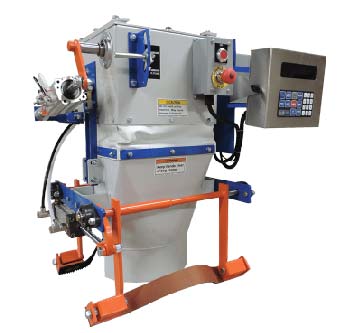A producer of organic potting soils and landscaping products in Washington State was seeking an automated system for bagging its products. It had been using a manual line that was comprised of a combination of homegrown and purchased system components. The old system required the operators to fill bags by look and touch. Then they would manually lift and transfer them to a check scale to be “OK’d” or topped off. Next, they would manually lift and handle them through a bag sealer and a manual stacking station another operator would stack a pallet. Additionally, more operators were required to build the batch in the blender so that the system could run continuously.
In total, the old line required 4 operators between bagging and palletizing. The Choice Bagging Equipment sales team listened carefully to their objectives. They wanted to reduce the number of personnel committed to the line so they could free them up to complete other tasks. They also wanted a system that would increase the production capacity to 10 bags per minute. They also wanted a system that would be safe and ergonomic for their operators.
CBE designed a system that had a large live bottom hopper that would allow them to store multiple batches at the bagging station. Bag hanging was completed manually. However, the new automated controls featured a filler integrated digital weighing system that would automatically clamp the bag, fill it to weight and discharge it onto a waiting conveyor belt that would automatically transport it to the bag sealing station.
After the bag was fed into the sealer, the rest of the process was fully automated. Bags were automatically laid on their backs and transferred through an inclined bag flattening conveyor that leveled and compressed the bag contents and removed excess air that was inside the bag from the filling and sealing process. After exiting the bag flattener, the bags entered a robotic bag palletizing system. The layout that was chosen for this system was a “hot swap” system which eliminated the need for empty pallet dispensing and a filled pallet handling conveyor. Instead, this system had pallets directly on the floor. The barrier guarding the robot was divided into two sections. The robot would stack in one section while system operators could safely access the other section to remove filled pallets or load new empty pallets into the system. The mode of operation was continuous and it did not require the system to be stopped to reload or remove materials.
With the new system, all lifting and manual handling of filled bags were completely eliminated. Filled bags were automatically transferred from filling to sealing and finally to palletizing stations without operator assistance. The robotic palletizer did all of the lifting and stacking of the filled bags.
The new system increased production capability from 3-5 bags per minute to 10-12 bags per minute while reduced the number of line operators from 4 to 2. The working environment was greatly improved because all of the filled bag handling was completely eliminated. Additionally, with the inclusion of the bag flattener and the consistency of the robotic palletizing system, the look and appearance of the pallets were enhanced and resulted in a much more attractive finished product.


Recent Comments